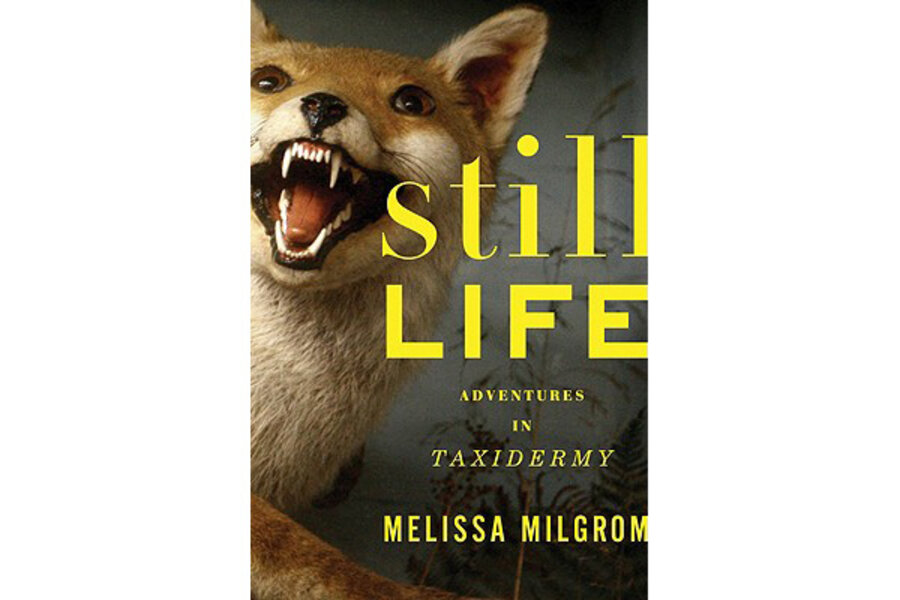Still Life
Loading...
The French use the expression jolie laide to describe something that is attractive and repulsive at the same time. In English, we might call it “taxidermy.”
At least that’s journalist Melissa Milgrom’s interpretation. After stumbling on a carcass waiting to be stuffed, and finding herself simultaneously fascinated and repelled, she took it upon herself to learn about the art, history, and science of taxidermy – that is, arranging (taxis) a skin (derma) over a manikin to resemble a once-living creature.
Most readers will correctly associate taxidermy with deer heads or dioramas. Or with serial killers. Milgrom reports that cannibal Jeffrey Dahmer wanted to be a taxidermist, and she begins Still Life with a quote from Norman Bates in “Psycho”: “My hobby is stuffing things – you know, taxidermy.”
The quote is a tip-off that “Still Life” is not going to be so much about the mechanics of taxidermy as about its associations. Each chapter focuses on a working taxidermist, and all have plenty to say about how maligned their beautiful and important profession is. As a participant-observer in their studios and homes, Milgrom is a sympathetic, even tender advocate. Some of her best lines strike analogies between taxidermy and more widely appealing phenomena: taxidermists’ work is “a motionless zoo”; “a dead circus coming to life”; a kind of karaoke.
Under Milgrom’s direction, readers may find themselves more interested in – and entertained by – the world of taxidermy than they thought imaginable. At one high-stakes competition, a man walks into the hotel lobby carrying a giant panda. The judges prepare to pounce on him for illegally acquiring an endangered species, but the joke is on them: “Thing-Thing” is in fact an amalgamation of two brown bears bleached with Clairol hair dye.
The trouble is that it’s hard to find the thread that connects all Milgrom’s reportage. This is a shame, not only because the book could benefit from more of a narrative to propel the reader along, but also because it appears as if there’s a real story to be told. The history of taxidermy would seem to offer insight into cultural history.
In its earliest forms, taxidermy was a tool to accompany exploration. It allowed travelers to bring home exotic specimens, edifying scientists and entertaining the public.
In the Victorian Age, British taxidermists anthropomorphized kittens and frogs into tableaux evoking weddings, pubs, and nursery rhymes – representations attesting to the unity of all God’s creatures, all deserving of a cigar and a shoe shine.
For early European-Americans, stuffed moose and elk were important evidence that animals did not shrink in the New World. At the turn of the 20th century, Teddy Roosevelt’s preserved African elephants trumpeted the dominance of man and the spirit of the frontier.
While Milgrom has documented this history, the reader can easily get lost in the details and chronology. She is clearer about the modern state of taxidermy. In several vivid scenes, she shows how taxidermists went from being the stars of the American Museum of Natural History to the behind-the-scenes laborers at the Smithsonian, in which the flesh-and-fur specimens are mere props for cutting-edge special effects.
Perhaps to show solidarity with her new friends, Milgrom eventually skins and mounts her own squirrel. Readers who can keep their eyes on the page will experience a miniature ball separating from its tiny socket and the smell of a saline pickle solution for small animals. Still simultaneously fascinated and disgusted, Milgrom manages not only to finish the job, but to enter the squirrel in a taxidermy contest.
I will not spoil the results of the contest, but I will echo one of the judges, who congratulated Milgrom’s efforts but observed that perhaps she didn’t love her squirrel quite enough. If there’s one thing that Milgrom’s investigation has made clear, it’s that taxidermists love animals, whether living, dead, or decomposing.
Instead, Milgrom appears to really love people. The pleasure of “Still Life” is entirely in the characters: Thing-Thing’s karaoke-singing creator and Damian Hirst’s foul-mouthed colleague are rendered as carefully and lovingly as any 12-point buck or departed pet. These miniprofiles are not quite enough to sustain an entire book, but they provide a nice opportunity to observe idiosyncratic human beings in their natural habitat.
Kelly Nuxoll is a freelance writer in Washington, D.C.






